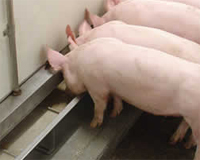Fermented liquid feeding for pigs: Knowledge of processes stressed

A recent study, published by scientists at Aarhus University, Denmark, gave a good overview of the current state of affairs in research related to fermented liquid feeding (FLF) in pigs. Knowledge of the process is vital, they say.
The study, carried out by Nuria Canibe and Bent Borg Jensen, was published in Animal Feed Science and Technology, in January 2012. It zooms in on fermented liquid feed and touches on microbial and nutritional aspects and impact on enteric diseases in pigs.
Good microbial quality
The scientists write: “In order to obtain fermented liquid feed (FLF) of good microbial quality, that is, biosafe, fresh feed and water are mixed with material from a previous successful fermentation, which acts as inoculum for the new mixture.”
The scientists write: “In order to obtain fermented liquid feed (FLF) of good microbial quality, that is, biosafe, fresh feed and water are mixed with material from a previous successful fermentation, which acts as inoculum for the new mixture.”
“Several factors affect the microbial and nutritional characteristics of the final product and therefore knowledge on the impact of these factors on the characteristics of the mixture is crucial. The initial hours of incubation are characterised by high pH, low numbers of lactic acid bacteria and yeasts, high numbers of Enterobacteriaceae, and low concentration of lactic acid, whereas at later hours of incubation, the pH decreases, the number of lactic acid bacteria and yeasts, and the concentration of organic acids and ethanol increase, whereas the Enterobacteriaceae counts decrease.”
Antibiotic replacement
The use of FLF has increasingly been found to be a replacement for using antibiotics as scientific proof is growing for the use against pathogenic enteric bacteria, the scientists write.
The use of FLF has increasingly been found to be a replacement for using antibiotics as scientific proof is growing for the use against pathogenic enteric bacteria, the scientists write.
“The effect of FLF on gastrointestinal health of pigs is one of the subjects being investigated in the last years. Feeding FLF of good quality results in reduction of the number of enteric pathogens like coliforms and Salmonella, and the few published studies on its effect on important pig diseases like porcine proliferative enteropathy (PPE) and swine dysentery also indicate reduction of the incidence of these diseases in pigs fed FLF.”
Free lysine
As was reported in Pig Progress 24.02 (2008), lysine control is vital in order to create better FLF. Often, free lysine is degraded into cadaverine during fermentation. The researchers write: “The extent of this degradation is affected by various factors, including feed processing and temperature of incubation. Coliform bacteria are related to free lysine degradation. The possible contribution of other micro-organisms present in the FLF to this degradation is uncertain, though.”
As was reported in Pig Progress 24.02 (2008), lysine control is vital in order to create better FLF. Often, free lysine is degraded into cadaverine during fermentation. The researchers write: “The extent of this degradation is affected by various factors, including feed processing and temperature of incubation. Coliform bacteria are related to free lysine degradation. The possible contribution of other micro-organisms present in the FLF to this degradation is uncertain, though.”
“Liquid fermentation has the potential of improving the nutritional value of feed ingredients. Data show that fermentation can improve digestibility of various nutrients, e.g., organic matter, nitrogen, amino acids, fibre, and calcium. The conditions of fermentation and the ingredients used are crucial factors in order to benefit from this, though.”
“Further, there are some strategies that can help improving the microbial and nutritional characteristics of FLF, such as addition of starter cultures, organic acids, or enzymes. Other strategies can help avoiding degradation of the amino acids, like adding the free amino acids immediately prior to feeding.”
Interest
The authors write that the use of liquid feed in pig nutrition has recently gained interest due to several reasons:
The authors write that the use of liquid feed in pig nutrition has recently gained interest due to several reasons:
· The political wish of decreasing the use of antibiotics in pig production;
· The current fluctuations in feed prices what makes liquid feed, with the possibility of using cheap liquid ingredients, an interesting feeding strategy;
· The policies aiming at increasing production of renewable biofuel with a corresponding increase in liquid co-products from the bioethanol industry, suitable for liquid feeding;
Environmental policies aiming at decreasing disposal of waste, for example, liquid co-products from the food/pharmaceutical/biofuel industry, that can be included in liquid feeding.











